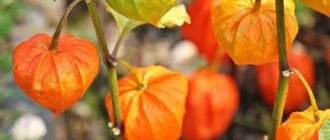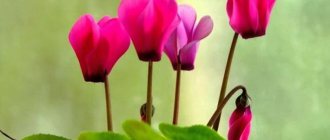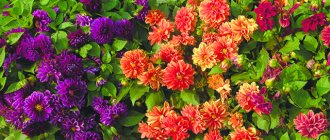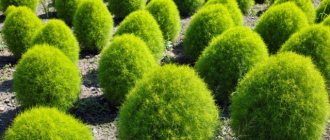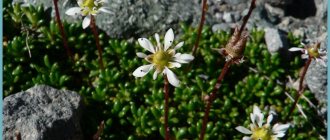When to plant salvia
From sowing seeds to flowering – 3-4 months. Currently, there are also hybrid varieties on sale that bloom earlier. Read the packaging!
For seedlings
Usually, seeds are sown to obtain seedlings from the second half of February to the beginning of April. Then you can get flowering already at the beginning of summer.
Directly into the ground
Salvia is planted with seeds directly into open ground no earlier than May.
Before winter
Perennial salvia is sown in the fall, before frost.
Sage is planted in the ground when the threat of frost has passed - it is important to take this into account. The plant is afraid of frosts below 3-5ºC.
When to plant salvia according to the lunar calendar 2022
To get strong seedlings and well-flowering salvia, it is useful to stick to certain days for planting seeds, and then seedlings in the ground.
Favorable days to plant salvia seeds in 2022:
| Month | Better days | Month | Better days |
| January | 23-27 | April | 3-7, 12-15, 21, 22 |
| February | 4-14, 17-23 | May | 2-5, 12-14, 18-25 |
| March | 3-16, 20-21 | June | 1-3, 6-13 |
The following days are identified as the most favorable for planting seedlings in open ground:
- May – 2-5, 12-14, 18-25
- June – 1-3, 6-13
In 2022, unfavorable days fall on the following dates:
- January — 2, 3, 17, 18
- February — 1, 2, 16, 28
- March — 1, 2, 18, 27, 28
- April — 1, 2, 16, 23
- May — 1, 16, 30
- June -14, 18, 29
- July — 13, 14, 28, 29
- August — 11, 12, 27-28
- September: 9-10, 26, 27
- October: 9, 10, 25, 26
- November: 1, 2, 7-9, 24, 25, 28, 29
- December: 7-9, 23-25
Main types and varieties with photos and names
All types of salvia are divided into 3 groups according to biological characteristics, as well as agrotechnical characteristics.
First group
The first group includes species belonging to the subtropics of America. In mid-latitudes they are grown as annual plants. They need constantly moist soil and warmth. Even a slight frost can destroy the plant.
Salvia splendens
The height of a compact bush can vary from 20 to 80 centimeters. It has very dense foliage. Oppositely located petiolar whole leaf plates have an ovoid shape. Their front side is painted dark green, and the back side is pale green. The large flowers have an irregular shape and a double perianth. They are whorled from 2 to 6 flowers in inflorescences in the form of a brush from 14 to 25 centimeters long. Typically, the corolla and calyx are deep red, but purple, white and pink can also be found. Flowering is observed from the beginning of summer until the first frost.
Salvia sparkling white is a variety of this plant. Its difference from the deep red one is that its inflorescences are more liquid and the calyx looks creamy against the background of a snow-white bract.
And the inflorescences of pink salvia are not so long compared to red ones. The calyx and corolla have the same pink color, but the surface of the corolla is velvety.
The sparkling violet salvia is a very showy plant. The fact is that the rich purple color is greatly enhanced by the thick pubescence.
Varieties that are more popular: Red Arrows, Fire Star, Sahara, Salvator.
Red Salvia (Salvia coccinea)
A branching bush with straight shoots can reach a height of 50 to 70 centimeters. There is dense pubescence on the surface. The petiolate leaf plates are ovate-shaped and finely serrate along the edge. Their front side is bare, and on the surface of the back side there is pubescence. The length of the loose inflorescence varies from 15 to 30 centimeters. They contain whorled flowers with a long tube and a corolla painted scarlet-red. Flowering begins in July and ends with the onset of the first frost. Popular varieties: “Lady in Red” - the bush reaches a height of 40 centimeters, the color of the flowers is deep red; “Sherry blossom” - a bush of this early variety is about 40 centimeters high, and the flowers are pink.
Salvia farinacea
This unpretentious plant is long-flowering. The bush has a pyramidal appearance and reaches a height of 60 to 90 centimeters. Petiolate, entire leaf plates of an ovoid-oblong shape have pubescent veins. Quite long inflorescences (15–20 centimeters) are located on fairly high peduncles. They consist of from 5 to 28 flowers of two centimeters in length. Most often the corolla is colored dark blue, but white is also found. Flowering begins in the second half of August and ends in late autumn. Popular varieties: “Anschuld” - the flowers have a whitish-silver color; “Strata” - blue flowers are located on a compact bush; "Victoria" - the variety blooms very profusely, the flowers are dark blue.
Second group
The second group includes Mediterranean species. They are not afraid of drought and are more frost-resistant. Loose soil is ideal for them and requires mineral fertilizers.
Green or variegated salvia (Salvia viridis)
Among the representatives of this species, only the Horminum variety is decorative. Her bracts are painted in a rich color. The bush of this annual plant reaches a height of 40–60 centimeters. There are a large number of straight branching shoots, on the surface of which there is glandular fluff. The surface of the elliptical-oblong petiolate leaf plates has pubescence. The length of simple inflorescences varies from 18 to 30 centimeters. They consist of false whorls with 4–6 flowers, the corolla of which is colored pink. But the bracts, which have a rich purple or pink color, catch the eye. Popular varieties: “White Swan” - the flowers are white, and the bracts are purple or pink; "Oxford Blue" - violet-blue bracts; "Pink Sunday" - pink bracts.
Salvia verticillata
The bush has ascending or straight shoots with dense pubescence and a height of 35 to 40 centimeters. The unusually shaped leaf blades are long-petioled and pubescent. The flowers are collected in dense whorls of 5–30 pieces and have a blue-lilac corolla. The variety “Purple Rain” is distinguished by flowers with purple cups and a dark purple corolla.
Salvia dandelion (Salvia taraxacifolia)
This herbaceous plant has a basal leaf rosette. Slightly branching straight shoots. Any part of this plant has a pleasant smell. The pinnately dissected leaf blades have an irregularly serrated edge. The front side is bare, and the back side is pubescent. The length of simple inflorescences can reach 28 centimeters. They consist of whorls with several flowers, the corolla of which is colored light pink, and the throat is light green with purple dots.
Salvia jurisicii
It also belongs to this group, but gardeners rarely grow it.
Third group
The composition includes frost-resistant species. These are the species that grow in the temperate climate of the Old World, and they also include Ethiopian salvia. These plants are distinguished by the fact that they bloom very luxuriantly from the second year of life. They are not capricious, shade-tolerant and frost-resistant. They need to be covered only when there is scanty snow cover in winter.
Oak forest salvia (Salvia nemorosa, Salvia sylvestris)
The height of the bushes reaches 60 centimeters; there is pubescence on the surface of the branched shoots. The sessile leaf plates located in the upper part are smaller than the lower petioles. The inflorescences have several pairs of lateral branches. They consist of false whorls, and each has from 2 to 6 small flowers. The color of the corolla is violet-blue. There are quite large purple bracts that are conspicuous. Flowering begins in the last days of June and lasts until the beginning of autumn. Popular varieties: dark lavender “Plumosa”, blue-violet “Mainakht”, violet-pink “Amethyst”.
Salvia glutinosa
Feels good in mid-latitudes. The height of a large bush can reach 0.9 meters. There are many straight pubescent-glandular shoots. The long-petiolate, large, serrated leaf blades are triangular-ovate in shape and greenish-yellow in color. Loose inflorescences consist of flowers in whorls. The corolla is pale yellow. Flowering lasts from the end of summer to the end of autumn.
Planting salvia in the ground
It is better to choose light, permeable soil with plenty of sand for sowing salvia. It should also contain lime and humus.
Almost all salvias love sunny places. Only a few varieties can grow in partial shade (for example, Salvia adhesive). The place should be sheltered from the wind.
Seedlings are transplanted into open ground after the threat of night frosts has passed. As a rule, in the south it is May, in the central part of Russia it is mid-May, in the northern regions it is early June.
Salvia bushes are planted in small holes at a distance of 25-30 cm from each other. It is advisable to first add a handful of humus to each hole.
Features of care
In hot summers, salvias need abundant watering; the rest of the time they need a small amount of water. It is best to use a drip system. It is advisable to carry out the procedure in the evening.
The next day after watering, it is recommended to loosen the soil. Feeding is usually carried out twice per season. This is done during the period of growing seedlings and at the time of bud formation.
Growing perennial salvia is somewhat more difficult. It requires pruning and shaping the bush. This is done to stimulate the growth of new shoots.
Typically, mass flowering begins as early as June, and continues until frost in the autumn months.
But different types of this plant have their own characteristics of flower formation. For some, flowers form twice per season. This is what characterizes Salvia sylvestris. After it finishes its first bloom, its stems are cut back and after they regrow, flowers appear again in late summer. It is recommended to feed this plant with fertilizers.
@Graeme Jones, Flickr
Wintering perennial salvia
Before the winter cold, the stems are cut so that 10-12 centimeters remain above the ground, the lower leaves are removed.
In the northern regions, perennial salvia should be dug out of the ground with the onset of cold weather and stored in a bright room in boxes with soil. The temperature must be above 0ºC.
Features of care
Growing
You need to care for this flower in the same way as most others. It needs to be weeded, watered, fed in a timely manner, and the soil surface must be loosened. Watering should be done only when the soil is completely dry and always in the evening. Remember that you should not pour a large amount of water, because if the liquid stagnates in the soil, the root system of salvia can easily rot. After the water is absorbed into the soil, its surface must be loosened, and at the same time weeds must be removed. During the season, this plant needs to be fed with complex mineral fertilizer at least 2 times. It is necessary to feed the plants with a weak nutrient solution when they are still in the house in boxes. The second time this procedure is carried out during budding.
Perennial salvia is somewhat more difficult to care for than annual or biennial salvia, which are sown with seeds before winter. The thing is that these plants need formative pruning. It will protect the shoots from being pulled out and exposed, and the plant will also become bushier, as young stems will actively begin to grow. At the end of flowering, do not forget to remove all faded flowers from the salvia. Before wintering or at the beginning of the next period of intensive growth, the bush will need to be trimmed. To do this, you need to remove the old stems that have become woody, so that only a few centimeters with buds and young greens remain.
Diseases and pests
This plant is resistant to almost all types of diseases. However, harmful insects such as thrips, mites, whiteflies, aphids, as well as snails and slugs that eat salvia leaves can settle on it.
You can get rid of slugs and snails by picking them up with your hands. To do this, you can lay out pieces of slate or rags between the plants, and then systematically collect pests hiding under cover during the daytime. You can also make traps. To do this, you need to place several saucers filled with fruit juice or beer on the site. Slugs, like snails, love these drinks and crawl away, attracted by their aroma; all you have to do is collect them. Make special umbrellas that can protect the saucers from precipitation and debris.
To kill other harmful insects, you will need appropriate insecticides.
Salvia after flowering
The flowering of such a plant begins in June, and when it ends depends directly on the species (sometimes only with the onset of the first frost). There are species that bloom twice a year. For example, when the flowering of forest salvia ends, it is recommended to cut off its shoots completely; in this case, at the end of the summer period, the bush will bloom again, especially if fertilizers are added to the soil. After such a perennial plant has finished blooming completely, it needs to be cut off, and then sprinkle the surface of the soil with a layer of mulch (garden compost), paying special attention to the growing points. In this case, salvia will be prepared even for severe winter frosts. For greater reliability, it is also recommended to cover young bushes with dried leaves or spruce branches.
Bulbous border flowers
Of the bulbous plants used to create flower borders, crocuses, tulips and daffodils are most often used. Bulbs are planted in the fall - in September and October, depending on the region. When cultivating the soil, all plant residues are carefully removed. The planting depth of the bulbs is chosen depending on the type.
The disadvantage of arranging a bulbous border is the significant labor costs
Monoflowers
They consist only of marigolds.
This flower garden is the best option for a beginning gardener. A flowerbed of any simple geometric shape is planted with Chernobrivtsy, as they are affectionately called in Ukraine, of the same variety. Preference is given to low flowers with large inflorescences. When planted densely enough, at least twenty-five centimeters between plants, they give the effect of a flower carpet. Varieties of low-growing marigolds for such a flower garden: “Lemon Miracle”, “Orange Snow”, “Eskimo” with white flowers. All of them have a height of 35 centimeters and inflorescences with a diameter of 6 to 8 centimeters. The work of creating such a flower bed is simple, but the result is impressive. You can shade a single-color flowerbed with a border of marigolds in a contrasting color or alternate plants of two colors. It is quite easy to break a round monoflower bed. It can consist of regular concentric circles, then the center of the composition coincides with the center of the flowerbed. You can move it and get a traditional flower garden of an original design.
Scheme of a round monoflower of marigolds
Floral design, options
The flower beds are one color. Varieties of marigolds.
Orange.
- Highs: “Solar Giants Orange”, “Sierra Orange”.
- Middle: "Golden Giant".
- Low: “Taishan F1 orange”, “Marvel orange”, “Apricot Primo”.
Yellow.
- High: “Marie Helen”, “Yellow Solar Giants”.
- Medium: “Citronenprince”, “Sierra yellow”, “Lemon giant”.
- Low: “Taishan F1 yellow”, “Ekinoks yellow”, “Khokhloma yellow”, “Petit Gold”.
Marigolds "Marvel Orange"
Marigold "Marie Helen"
From these varieties you can create both a single-color and a combined flower bed.
The composition consisting of three flower beds looks interesting. They can be either at the same level or at different levels. Each flowerbed is populated with marigolds of the same color and height.
Scheme of three marigold flower beds
The following marigold varieties are suitable for the flowerbed:
- "Golden Giant";
- "Marvel F1 orange";
- “Honeycomb”, red with a brownish tint, or “Eskimo”, vanilla-white in color;
- Lawn.
Flower beds
When creating any flower bed, we first pay attention to the duration of flowering. The flowerbed must meet the requirement of continuous flowering.
When choosing a flower bed assortment, you need to clearly know the conditions for flower growth. The main criteria are soil composition, microclimate, moisture content. The marigold flower does not have any special requirements for soil, but prefers loamy soil.
Blooms profusely and spectacularly in sunny areas of the site. The flower is also grown in shade and partial shade. The flower needs to be watered regularly, although it will easily survive a slight drought.
Asters go well with marigolds
Combination of marigolds with other flowers
Who to choose as your flowerbed neighbors for marigolds depends on the preferences of gardeners and gardeners. The best partners for marigolds are calendula, heliotrope and echinacea.
Marigolds create a wonderful union with white and purple petunia. They look great in flower beds and mixborders next to fragrant tobacco, alyssum, ageratum, coleus, zinnias and asters.
White petunia surrounded by marigolds
On an alpine hill, the perennial clearweed looks good next to the marigolds. Combine effectively with ornamental grasses. The combination of red salvia and yellow marigolds is always pleasing to the eye.
Important: Try not to plant marigolds next to roses, radishes and beans.
Flower bed schemes
Round flower bed
1. Alyssum (10 – 15 cm height) 2. Ageratum (15 – 25 cm height) 3. Petunia (25 – 40 cm height) 4. Tagetes (40 – 60 cm)
Rectangular flowerbed.
1. Low-growing New Guinea balsam 2. Tagetes 3. Tree heliotrope. Flowerbed letter
Planting marigolds in the shape of a letter (G, S, P, etc.)
1Tagetes
Square flower bed.
1. Salvia (red) 2. Tagetes (golden) 3. Coleus (green)
Watch the video Marigolds are beautiful and healthy flowers for the garden with medicinal properties
How to properly care for salvia in summer
Salvia is very easy to care for. Simple standard procedures include watering, weeding, mulching, loosening, and fertilizing.
What to feed for abundant flowering
In order for salvia to delight with an abundance of color, it needs proper nutrition. In the flowerbed, flowers are fertilized 5-7 days after planting. The menu offers her growth stimulants and minerals. As soon as the plant begins to form buds, the next feeding is carried out.
Salvia will bloom abundantly if it manages to develop its above-ground part well. Like nothing else, this is facilitated by nitrogen, found in proper quantities in bird droppings, humus, and manure.
The infusion of such organic matter should be poured over the transplanted salvias, and in a very short time they will become much healthier. Flowering is also promoted by potassium, which helps absorb water and phosphorus, which ensures normal development.
Salvia Cassiopeia
Some flower growers who do not have the proper experience and are poorly versed in various fertilizers can use tips from manufacturers. Many nutritional compositions speak for themselves: Ovary, Bud, and so on.
Experienced flower growers prefer traditional methods to all factory-made fertilizers. To prolong and enhance flowering, they use an ash solution. Also pour boiling water over the skin of bananas and peel potatoes for a week.
Before the buds open, it is useful for salvia to water it with water infused with egg shells.
Reproduction methods
Salvia reproduces in several ways. Perennial varieties can be divided from the rhizome, propagated by cuttings, and sown by seeds. But one-year-olds and biennials are propagated exclusively by seeds: direct sowing and through seedlings.
Seeds are sown in spring and autumn, before winter. However, there are varieties that can only be grown using seedlings. These are all varieties belonging to the type of salvia sparkling.
When and how to collect your seeds
High-quality material will be obtained exclusively from varietal flowers. Fading inflorescences are cut and dried. Do this not in the sun. The inflorescences are laid out under a canopy in the fresh air or in a ventilated room. You can collect a lot of seeds from dried seed pods.


